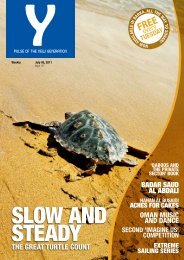Issue - Y-oman.com
Issue - Y-oman.com
Issue - Y-oman.com
You also want an ePaper? Increase the reach of your titles
YUMPU automatically turns print PDFs into web optimized ePapers that Google loves.
CAN YOU EVERBE THIN ENOUGH?Priyanka SachetiA few weeks ago, I found myself participating in abody-shape evaluation at the behest of a particularorganization here in Muscat; honestly speaking, I wentin without any particular expectations, filled with onlycuriosity instead as to what the evaluation wouldreveal. What I learnt was that while I happened to beten kilograms underweight for my particular Body MassIndex (BMI), the fat in my body was rather unequallydistributed and that my body-shape consequentlyneeded corrective toning. Or so the body-shapeevaluation chart unequivocally seemed to think.The matter of thinness is subject to individual perceptionand interpretation. What you see when looking atyourself in the mirror is entirely different to how othersmay perceive you. If the camera seemingly adds poundsto your figure, it also appears that the mirror (or at least,the one that you happen to be facing) is hell bent ondoing the same.What women are conditioned to believe is an ideal bodyshapevis-a-vis a healthy body-shape; this has be<strong>com</strong>ean even more contentious debate in a world dominatedby information-overload, continually publishing andbroadcasting images of what constitutes the universalnotion of ideally-figured women, and digitally-alteredby the tools of technology. Can you ever be thin enoughin this world?What was considered to be an ideal women’s bodyshape has itself undergone change over history; duringthe eighteenth and nineteenth centuries, an hour-glassshaped figure was en vogue while post-WW1, a thinner,scrawnier figure became much more fashionable;the fifties of the last century witnessed healthierproportions, although the advent of the supermodel,Twiggy (the name itself is reflective enough) during theseventies signaled an era in which the desired bodyshapebecame thinner and thinner until it virtuallybordered on being waif-like in the nineties and presentcenturynoughties.The fashion industry, including fashion designersand fashion magazine editors, have always bornethe brunt of charges accusing them of encouragingand endorsing extremely unhealthy women’sfigures. While it is understandable that the model isultimately but a medium to showcase the garment,is it necessary to virtually obliterate the model’sphysical personality in order to do so?Glamor magazine’s US Edition last summerpublished a plus-size model picture in its magazineand attracted much attention; Elle magazine’s Frenchedition recently featured fuller-figured modelson its cover. Yet, both magazines’ actions wereconsidered as mere gestures, rather than accuratereflectors of the fashion industry’s inclination toaccept plus-size models into its fold. While there isan emerging awareness of the necessity of ensuringthat models have healthier proportions, how manyfashion moguls or editors are willing to or actuallydo support this particular trend through their showsand editorials?Research has shown thatbody-image issues originatefrom early childhood itself;what with being constantlybombarded with images ofunrealistically thin bodiesin media, girls begin toassociate thinner figures withmore positive and notably,successful connotations. Forexample, last November,supermodel Kate Moss stirredmuch controversy with herstatement, “Nothing tastesas good as skinny feels.” Idolised as much for herfashion sense as for her skinny figure by legionsof teenage girls worldwide, it was widely felt thatMoss should have weighed her words much morecarefully on the issue.Whatever the age or stage in life, women findthemselves forever attempting to achieve that bodyshapeideal. In the age of celebrity yummy mummies,women who have just given birth find themselvesfacing tremendous pressure to swiftly lose weight; ie,to jettison the mummy tummy and be<strong>com</strong>e a yummymummy instead, perfectly coiffed and dressed with amade-to-order figure to match. Being a mother doesnot exempt you from the scourge of possessing anundesirable figure; in fact, having temporarily lostyour shape is more than enough of an indicator toregain it lest it seemingly never returns – and woebetide that eventuality!Yet, celebrity mummy and distinguished actress, KateWinslet, has always conspicuously stood out for herrefusal to buck the weight trend. She vehementlyprotested in 2003 when leading UK men’s magazine,GQ, admitted to having digitally altered Winslet’scover image without the actress’ knowledge; ironicallyenough, she had been championing the cause offuller-figured women in that particular issue itself.And in fact, as recently as last December, she wasvoted the celebrity body that most British womenwould wish to have in a British survey, indicating apositive body-shape role model for women.It may seem an ever-present struggle to reconcile thefigure in one’s mirror with that of a more desirableone; ultimately, it lies within the individual to drawthe line between the two.
















